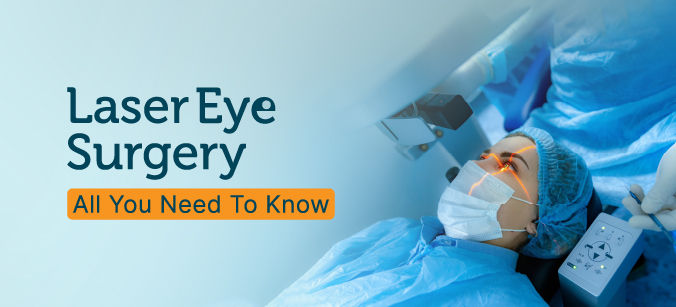General Health
How Does Laser Eye Surgery Work?
7 min read
By Apollo 24|7, Published on - 30 November 2022, Updated on - 24 January 2023
Share this article
0
1 like

Just imagine yourself walking on a beautiful beach in Andaman. Greenery all around, water as clear as glass. Frothy waves roaring in, sand in your hair and tiny white shells beneath your feet!
It’s roughly 4’o clock, just the time for sunset! The sky turns golden and the sunlight refracts through 7 directions from a cloud. Beautiful! Isn’t it? You of course want to capture this moment forever. So you take out your phone and click!
But zzzoooop! You forgot to bring the lens to focus and now the photo comes out blurry. Lots of colours and figures, but no clear outline.
This ‘out of focus’ picture is the closest to how a person with refractive errors sees the world. No matter how pretty the view or how perfect the lighting is, the world always seems a little out of focus. And this is exactly what laser eye surgery solves. Much like how you manually adjust the camera lens to bring a picture to focus, laser surgically adjusts your eye lens to bring the view to focus.
How Does the Human Eye See?
The human eye, much like a camera, works on the principle of refraction.
The light from everything around enters your eye through two refractive surfaces- the cornea (outer lens) and the lens (inner lens). Together, they refract light in such a way that it accurately focuses the image on the inner eye sensor, that is- the retina, which further connects with the brain to give rise to vision.
What are Refractive Errors? | Types and Causes
Refractive errors, in the simplest sense, are when our eyes are unable to see clearly. Instead, everything around appears out of focus and blurry. This primarily happens because of a structural error in the eye’s refractive process.
Ideally, the light from everything around should refract in your eyes in such a way that it accurately focusses on the retina sensor. This accuracy of focus is what lends clarity to the vision. However, the problem begins when the cornea or the lens starts to develop out of shape and hence ends up focusing the light a little before or outside the retina.
- When the focus falls before the retina, it is called myopia- a vision condition where the nearby objects are clear but the far away objects appear blurry.
- Contrastingly, when the focus falls outside the retina, it is called hyperopia- a vision condition where the far away objects appear clear but the nearby objects are blurry.
- Another common refractive error is astigmatism. Here, the cornea distorts away from its spherical shape and so all objects, weather near of far, appear out of focus and unclear.
DidYouKnow
Hormonal changes during pregnancy and nursing might negatively impact a patient's vision, making these times unfitting for the laser eye procedure.
Can Refractive Errors Be Corrected? | 3 Possible Solutions
Yes, refractive errors can and must be corrected. Otherwise, you’ll find yourself excessively twitching or widening your eyes to help support an extra focus. This often leads to an excessive eye strain, eventually resulting in intense and regular headaches.
Three common solutions to refractive errors include-
- Wearing Spectacles
Spects are a pair of two extra glasses custom-made to compliment your refractive power. Once fixed before eyes, they work together with you natural lenses to refract light in such a manner that it accurately focusses on the retina sensor instead of falling before or after it. As a result, you ll find yourself seeing better and clearer. They are great for children and adults alike and are very simple to use.
- Wearing Contact Lenses
Much similar to the concept of glasses, contact lenses too, are custom made to your refractive power and help you see clearer by accurately focussing the refracted light on the retina sensor. However, unlike the traditional glasses, you can directly wear them on the top of your cornea and experience a clearer view, minus the bulkiness of extra glasses. But, note that they require comparatively more care, risk dryness and infections, and are typically advised only for adults over 18 years of age.
- Undergoing LASIK (Laser-assisted in situ keratomileusis)
Much like glasses or contact lenses, LASIK too works on the principle of refractive error correction. However, instead of solving the refraction through additional lenses, it directly corrects your cornea.
Here, the eye surgeon uses a high intensity beam light (laser) to cut open a small flap on your cornea. It is then swiftly reshaped in a manner such that it starts to refract light exactly on the retina sensor post recovery. The procedure is safe, quick, and offers long term results. The recovery too happens within 2 days, with you being able to achieve more than 60-70% clarity the same day.
DidYouKnow
People with thick corneas are not suitable LASIK candidates because they may have complications after surgery.
Types of Laser Eye Surgery
You can choose from a variety of procedures for correcting vision problems, depending on your needs and goals, like:
1. Laser-Assisted In Situ Keratomileusis (LASIK)
This is the most common eye laser surgery. Here the eye surgeon creates a partial-thickness corneal flap and ablates the corneal bed. The flap is then placed back.
- Time Duration: 30 mins or less
- Recovery Time: 6 to 12 hours
2. Epithelial Laser-Assisted In Situ Keratomileusis (Epi-LASIK)
An epi-LASIK technique involves mechanically separating the epithelium from the stroma (the cornea's middle layer) with a blunt blade device (epikeratome), followed by laser reshaping of the cornea.
- Time Duration: 5 to 10 mins
- Recovery Time: 4 to 7 days
3. Laser-Assisted Subepithelial Keratectomy (LASEK)
LASEK is like LASIK, but the flap is generated with a microkeratome. The technique removes less cornea, making it an excellent alternative for thin corneas.
- Time Duration: 10 mins or less
- Recovery Time: 1 to 2 weeks
4. Photorefractive Keratectomy (PRK)
Unlike traditional flap surgery, the epithelium is simply scraped away during PRK. This is especially helpful for athletes, soldiers, and anyone else who faces a higher risk of eye injury.
- Time Duration: 5 to 10 mins
- Recovery Time: 1 month
5. Small-Incision Lenticule Extraction (SMILE)
This cutting-edge method of corneal refractive surgery involves creating a tiny lens-shaped piece of tissue (lenticule) just under the cornea's surface with a laser. After the cornea has been reshaped using the lenticule, it is surgically removed through a tiny incision.
- Time Duration: 5 to 7 mins
- Recovery Time: 3 months
6. Intraocular Lenses
Intraocular lenses are corrective lenses that are surgically implanted in the eye to correct eyesight. If you have cataracts or nearsightedness that can't be fixed with LASIK, this operation may be right for you.
- Time Duration: 20 to 30 mins
- Recovery Time: 8 weeks
Should You Have Laser Eye Surgery?
The prospect of laser eye surgery can be alluring if you regularly use corrective lenses like glasses or contacts to see clearly. Understand the pros and cons of laser eye surgery before undergoing laser eye surgery.
Recovery Tips for Laser Eye Surgery
- Stay inside and out of the sun
- Spend a day or two having someone else take care of the kids, the pets, and the housework
- Make sure you have someone to help you get settled in at home after surgery
- Plan ahead for your post-op diet is essential
- Refrigerate your eye drops
- Get yourself a thin cold compress and place it over your eyes
- Make sure to take a bath or shower the morning of your surgery
- Stay away from the TV and phone when you get home
- Configure your cell phone settings to comfort if you have to use
- Finally, rest, rest, rest and repeat
Final Note
You may be considering LASIK surgery if you're fed up with corrective lenses like glasses or contacts. However, it isn't a good fit for everyone. See if you qualify by consulting with professionals today!
Reviewed by Dr. Dhanunjay Reddy B
General Health
Leave Comment
Recommended for you

General Health
What Is Parkinson’s Disease: Are You At Risk?
Parkinson’s is a progressive disease that can adversely affect your physical and mental wellbeing.
%20(1).jpg?tr=q-80)
General Health
Makhana Benefits: Traditional Superfood & A Healthy Snacking Alternative
Discover the incredible health benefits of Makhana (fox nuts), a traditional superfood packed with nutrients. Learn how this nutritious snack can boost your health, improve digestion, and support weight management.
.jpg?tr=q-80)
General Health
Vitamins for Hair Growth and Thickness: Essential Nutrients for Fuller, Healthier Hair
Discover the best vitamins for hair growth and thickness. Learn how essential nutrients like biotin, vitamin D, and iron promote healthier, fuller hair. Boost your hair care routine with these vital vitamins for stronger, more vibrant locks!
Subscribe
Sign up for our free Health Library Daily Newsletter
Get doctor-approved health tips, news, and more.
Visual Stories

Could There Be More to Your Snore?
Tap to continue exploring
Recommended for you

General Health
What Is Parkinson’s Disease: Are You At Risk?
Parkinson’s is a progressive disease that can adversely affect your physical and mental wellbeing.
%20(1).jpg?tr=q-80)
General Health
Makhana Benefits: Traditional Superfood & A Healthy Snacking Alternative
Discover the incredible health benefits of Makhana (fox nuts), a traditional superfood packed with nutrients. Learn how this nutritious snack can boost your health, improve digestion, and support weight management.
.jpg?tr=q-80)
General Health
Vitamins for Hair Growth and Thickness: Essential Nutrients for Fuller, Healthier Hair
Discover the best vitamins for hair growth and thickness. Learn how essential nutrients like biotin, vitamin D, and iron promote healthier, fuller hair. Boost your hair care routine with these vital vitamins for stronger, more vibrant locks!